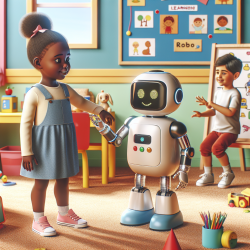As a practitioner, you might wonder how to incorporate these findings into your work. Here are some practical takeaways from the study:
Why Robot-Based Interventions?
Children with ASD often face challenges in social interaction and communication. Traditional human-based interventions can sometimes be overwhelming due to the complexity of human social cues. Robots, on the other hand, offer a controlled, predictable environment, making it easier for children with ASD to engage and learn.
Key Findings from the Study
The study involved Chinese-speaking preschoolers with ASD who were randomly assigned to either an intervention group or a wait-list control group. The intervention group received four 30-minute sessions of robot-based gestural training. The results were promising:
- Children in the intervention group showed significant improvement in producing accurate and appropriate intransitive gestures compared to the control group.
- The positive effects were maintained even in delayed posttests, indicating long-term benefits.
- Children in the intervention group also showed an increase in verbal markers while gesturing, which is a positive indicator of improved communication skills.
Implementing Robot-Based Interventions in Your Practice
Here are some steps to consider if you're looking to implement robot-based interventions:
- Start Small: Begin with a few sessions to gauge how your students respond to the robot-based training.
- Monitor Progress: Keep track of improvements in gestural accuracy and verbal communication. Use pretests and posttests to measure progress.
- Customize Training: Tailor the robot's gestures and stories to fit the cultural and linguistic context of your students.
- Engage Parents: Inform parents about the benefits and involve them in the process to reinforce learning at home.
Encouraging Further Research
While the results are promising, more research is needed to explore the full potential of robot-based interventions. Encourage your colleagues and other practitioners to delve into this area. Collaborative efforts can lead to more refined and effective strategies for helping children with ASD.
To read the original research paper, please follow this link: Robot-based intervention may reduce delay in the production of intransitive gestures in Chinese-speaking preschoolers with autism spectrum disorder.










